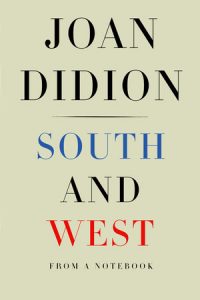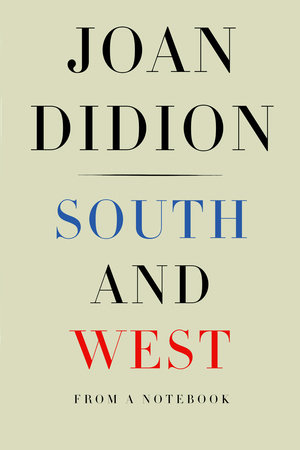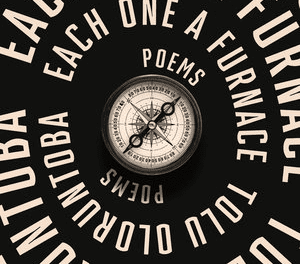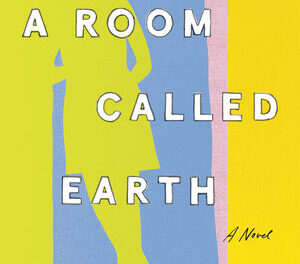This latest “What We’re Reading” post–about Joan Didion’s South and West: From a Notebook (Knopf, 2017)–comes from volunteer Ashley Anderson, a graduate student in the literary nonfiction program at the University of Cincinnati, who is headed to the University of Missouri next fall for PhD studies. Originally from Atwater, Ohio, Ashley’s work has appeared in Peripheral Surveys, SFWP Quarterly, and Assay: A Journal of Nonfiction Studies. When not writing, Ashley can often be found organizing something or cooking up a storm. Ashley Anderson: When I first got an email from Barnes & Noble a few months ago announcing a new book from Joan Didion, I thought this was too good to be true. New work? From Didion, someone who I’ve described as my spirit animal? I was sold instantly, preordering a copy before I had a chance to talk myself out of it. This new book, South and West: From a Notebook, harkens back to previous essays by this prolific writer by drawing upon notebook ephemera from two unwritten works: one examining the culture of the American South and one that was meant to follow the trial of Patty Hearst in January 1976. Her collection of notes, quotes, reminders, one-liners, directions, and descriptions of places and things are written in trademark Didion style, with precise and detailed language, wit, and a willingness to engage and tackle the world around her. Despite knowing that this unfinished material is taken directly from her notebooks, readers still feel the same weight and impact from Didion’s words as they do when reading her completed works. In his foreword to the book, Nathaniel Rich writes, “The effect [of reading Didion’s notes] can be jarring, like seeing Grace Kelly photographed with her hair in rollers or hearing the demo tapes in which Brian Wilson experiments with alternative arrangements of ‘Good Vibrations.’” Reading South and West is a bit like seeing the queen without her crown. While Didion’s readers are used to seeing seamless prose, the thrill is examining what lies beneath a polished exterior in order to understand how it works. The first section, which commands most of the attention in this short volume, details a trip Didion takes through the American South, mostly Louisiana and Mississippi. From the section’s opening line—“In New Orleans in June the air is heavy with sex and death, not violent death by decay, overripeness, rotting, death by drowning, suffocation, fever of unknown etiology”—we are transported to a different side of the famed city. This is true of most of the cities she depicts in her notes on the South, painting a picture of a place that wants to advance but is frozen in an economy that is no longer socially or economically feasible. The second section, just a small slice of the book, was meant to be Didion’s notes on the Hearst trial. Instead, these snippets of reflections, after many rounds of revision and repurposing, became her 2003 essay “Where I Was From.” Didion herself admits fairly early on that “This is not about Patricia Hearst. It is about me and the peculiar vacuum in which I grew up, a vacuum in which the Hearsts could be quite literally king of the hill.” In her notes, we see that vacuum: the trees, the parties, the misconceptions regarding one’s social status, and even a school “prophecy” that proclaims Didion to be the first woman president. This section on California continues to build a stark contrast between two poles in American culture: the South, deeply rooted in traditions and social codes that dictate every aspect of a resident’s life, and California, known for its continued push toward innovation in a liberal climate. Given the increasingly polarized atmosphere in the United States, this newly published book by Didion is more relevant now than ever. We have been asking ourselves how we became so divided on so many issues, and one possible answer is buried in Didion’s scribbles. In his foreword, Rich draws upon a 2006 interview Didion had with The Paris Review about why she wanted to use the South to understand California and vice versa. “It is a counterintuitive theory, for the South and the West represent the poles of American experience—the South drowning in its past, the West looking ahead to distant frontiers in a spirit of earnest, eternal optimism,” Rich writes, and yet therein lies the problem—seeking an answer or connection from those who are different, we may look only at our own culture and past. Despite being a collection of pages from her notebooks, Didion’s newest work still has the same power and capacity as her previous books and essays, a power we as an audience so desperately need right now—the power to find the solution for connection we’ve been searching for.
got an email from Barnes & Noble a few months ago announcing a new book from Joan Didion, I thought this was too good to be true. New work? From Didion, someone who I’ve described as my spirit animal? I was sold instantly, preordering a copy before I had a chance to talk myself out of it. This new book, South and West: From a Notebook, harkens back to previous essays by this prolific writer by drawing upon notebook ephemera from two unwritten works: one examining the culture of the American South and one that was meant to follow the trial of Patty Hearst in January 1976. Her collection of notes, quotes, reminders, one-liners, directions, and descriptions of places and things are written in trademark Didion style, with precise and detailed language, wit, and a willingness to engage and tackle the world around her. Despite knowing that this unfinished material is taken directly from her notebooks, readers still feel the same weight and impact from Didion’s words as they do when reading her completed works. In his foreword to the book, Nathaniel Rich writes, “The effect [of reading Didion’s notes] can be jarring, like seeing Grace Kelly photographed with her hair in rollers or hearing the demo tapes in which Brian Wilson experiments with alternative arrangements of ‘Good Vibrations.’” Reading South and West is a bit like seeing the queen without her crown. While Didion’s readers are used to seeing seamless prose, the thrill is examining what lies beneath a polished exterior in order to understand how it works. The first section, which commands most of the attention in this short volume, details a trip Didion takes through the American South, mostly Louisiana and Mississippi. From the section’s opening line—“In New Orleans in June the air is heavy with sex and death, not violent death by decay, overripeness, rotting, death by drowning, suffocation, fever of unknown etiology”—we are transported to a different side of the famed city. This is true of most of the cities she depicts in her notes on the South, painting a picture of a place that wants to advance but is frozen in an economy that is no longer socially or economically feasible. The second section, just a small slice of the book, was meant to be Didion’s notes on the Hearst trial. Instead, these snippets of reflections, after many rounds of revision and repurposing, became her 2003 essay “Where I Was From.” Didion herself admits fairly early on that “This is not about Patricia Hearst. It is about me and the peculiar vacuum in which I grew up, a vacuum in which the Hearsts could be quite literally king of the hill.” In her notes, we see that vacuum: the trees, the parties, the misconceptions regarding one’s social status, and even a school “prophecy” that proclaims Didion to be the first woman president. This section on California continues to build a stark contrast between two poles in American culture: the South, deeply rooted in traditions and social codes that dictate every aspect of a resident’s life, and California, known for its continued push toward innovation in a liberal climate. Given the increasingly polarized atmosphere in the United States, this newly published book by Didion is more relevant now than ever. We have been asking ourselves how we became so divided on so many issues, and one possible answer is buried in Didion’s scribbles. In his foreword, Rich draws upon a 2006 interview Didion had with The Paris Review about why she wanted to use the South to understand California and vice versa. “It is a counterintuitive theory, for the South and the West represent the poles of American experience—the South drowning in its past, the West looking ahead to distant frontiers in a spirit of earnest, eternal optimism,” Rich writes, and yet therein lies the problem—seeking an answer or connection from those who are different, we may look only at our own culture and past. Despite being a collection of pages from her notebooks, Didion’s newest work still has the same power and capacity as her previous books and essays, a power we as an audience so desperately need right now—the power to find the solution for connection we’ve been searching for.
What We’re Reading: South and West











